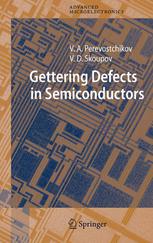

Most ebook files are in PDF format, so you can easily read them using various software such as Foxit Reader or directly on the Google Chrome browser.
Some ebook files are released by publishers in other formats such as .awz, .mobi, .epub, .fb2, etc. You may need to install specific software to read these formats on mobile/PC, such as Calibre.
Please read the tutorial at this link: https://ebookbell.com/faq
We offer FREE conversion to the popular formats you request; however, this may take some time. Therefore, right after payment, please email us, and we will try to provide the service as quickly as possible.
For some exceptional file formats or broken links (if any), please refrain from opening any disputes. Instead, email us first, and we will try to assist within a maximum of 6 hours.
EbookBell Team

4.3
68 reviewsGettering Defects in Semiconductors fulfills three basic purposes:
– to systematize the experience and research in exploiting various gettering techniques in microelectronics and nanoelectronics;
– to identify new directions in research, particularly to enhance the perspective of professionals and young researchers and specialists;
– to fill a gap in the contemporary literature on the underlying semiconductor-material theory.
The authors address not only well-established gettering techniques but also describe contemporary trends in gettering technologies from an international perspective. The types and properties of structural defects in semiconductors, their generating and their transforming mechanisms during fabrication are described. The primary emphasis is placed on classifying and describing specific gettering techniques, their specificity arising from both their position in a general technological process and the regimes of their application. This book addresses both engineers and material scientists interested in semiconducting materials theory and also undergraduate and graduate students in solid–state microelectronics and nanoelectronics. A comprehensive list of references provides readers with direction for further reading.